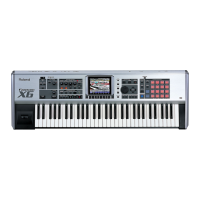115
Creating a Performance
D Beam (Solo Synth)
You can use the D Beam controller to perform in a way similar to on
a mono synth.
fig.09-014_50
For details on these settings, refer to
“Selecting the Parameter
Controlled by the Realtime Controllers or D Beam
Controller (Control Setting)”
(p. 114).
When you press [F7 (Panel View)], the Panel View screen will
appear, which displays the above parameters in graphical
fashion, simulating an analog synthesizer. From the Panel View
screen, you can press [F2 (Image View)] to open the Image View
screen, where you can see a graphical indication of the D Beam
output value. Press [EXIT] to leave this screen.To exit from this
screen, press [EXIT].
Settings for the Solo Synth are saved for system settings.
OSC 1/2 Waveform
Select the waveform.
SAW
is a sawtooth wave, and
SQR
is a square
wave.
OSC 1/2 Pulse Width
Specifies the pulse width of the waveform. By cyclically modifying
the pulse width you can create subtle changes in the tone.
* The Pulse Width is activated when “SQR” is selected with OSC1/2
waveform.
Value:
0–127
OSC 1/2 Coarse Tune
Adjusts the pitch of the tone’s sound up or down in semitone steps
(+/-4 octaves).
Value:
-48–+48
OSC 1/2 Fine Tune
Adjusts the pitch of the tone’s sound up or down in 1-cent steps (+/-
50 cents).
Value:
-50–+50
OSC2 Level
Adjust the level.
Value:
0–127
OSC1 Sync Switch
Turning this switch on produces a complex sound with many
harmonics. This is effective when the OSC1 pitch is higher than the
OSC2 pitch.
Value:
OFF, ON
Filter Type
Selects the type of filter.
OFF:
No filter is used.
LPF:
Low Pass Filter. This reduces the volume of all
frequencies above the cutoff frequency (Cutoff Freq) in
order to round off, or un-brighten the sound. This is the
most common filter used in synthesizers.
BPF:
Band Pass Filter. This leaves only the frequencies in the
region of the cutoff frequency, and cuts the rest. This can
be useful when creating distinctive sounds.
HPF:
High Pass Filter. This cuts the frequencies in the region
below the cutoff frequency. This is suitable for creating
percussive sounds emphasizing their higher tones.
PKG:
Peaking Filter. This emphasizes the frequencies in the
region of the cutoff frequency. You can use this to create
wah-wah effects by employing an LFO to change the
cutoff frequency cyclically.
Cutoff
Selects the frequency at which the filter begins to have an effect on
the waveform’s frequency components.
Value:
0–127
Resonance
Emphasizes the portion of the sound in the region of the cutoff
frequency, adding character to the sound. Excessively high settings
can produce oscillation, causing the sound to distort.
Value:
0–127
Level
Sets the volume.
Value:
0–127
Chorus Send Level
Sets the level of the signal sent to chorus.
Value:
0–127
Reverb Send Level
Sets the level of the signal sent to reverb.
Value:
0–127
LFO Rate
Adjusts the modulation rate, or speed, of the LFO.
Value:
0–127
LFO Osc 1 Pitch Depth
Specifies the depth to which the LFO will modulate the OSC1 pitch.
Value:
-63–+63
Fantom-X678_r_e.book 115 ページ 2005年5月12日 木曜日 午後4時40分

